HND Business (RQF) Unit 12: Organizational Behavior Analysis
VerifiedAdded on 2021/04/13
|26
|8720
|246
Report
AI Summary
This report analyzes organizational behavior within the context of Google LLC, exploring how culture, politics, and power influence individual and team behavior and performance. It delves into various motivation theories, including Maslow's hierarchy of needs, McClelland's theory, Skinner's reinforcement theory, and Vroom's expectancy theory, evaluating their application in achieving organizational goals. The report critically examines the relationships between culture, politics, power, and motivation, offering recommendations for team and organizational success. Furthermore, it differentiates between effective and ineffective teams, applying concepts of organizational behavior such as path-goal theory, social capital theory, and contingency theory to a given business situation. The report also evaluates the relevance of team development theories and philosophies in improving workplace performance and productivity, providing a comprehensive overview of organizational behavior principles and their practical implications.
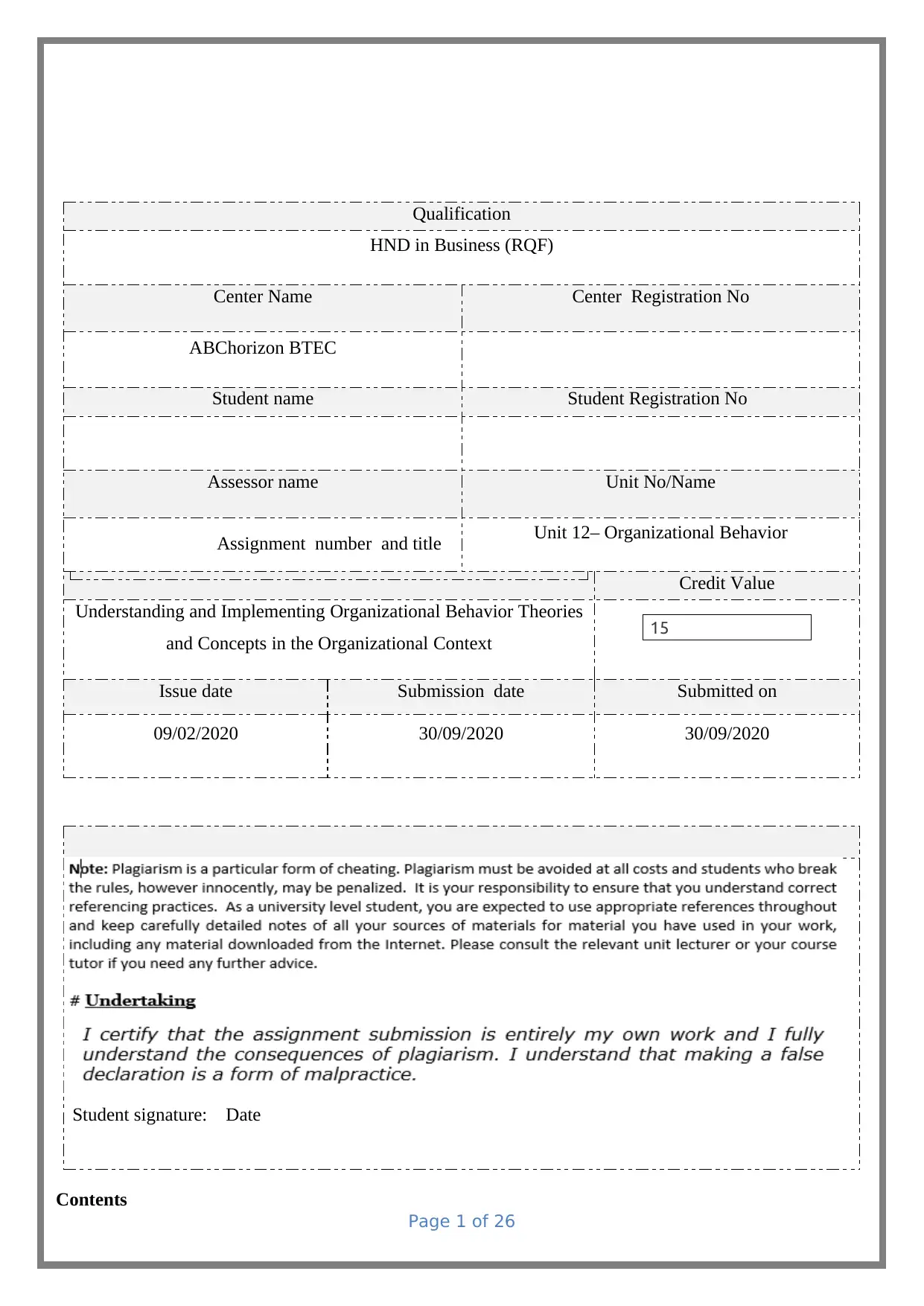
.
Qualification
HND in Business (RQF)
Center Name Center Registration No
ABChorizon BTEC
Student name Student Registration No
Assessor name Unit No/Name
Unit 12– Organizational Behavior
Assignment number and title
Credit Value
Understanding and Implementing Organizational Behavior Theories
and Concepts in the Organizational Context
Issue date Submission date Submitted on
09/02/2020 30/09/2020 30/09/2020
Student signature: Date
Contents
Page 1 of 26
Qualification
HND in Business (RQF)
Center Name Center Registration No
ABChorizon BTEC
Student name Student Registration No
Assessor name Unit No/Name
Unit 12– Organizational Behavior
Assignment number and title
Credit Value
Understanding and Implementing Organizational Behavior Theories
and Concepts in the Organizational Context
Issue date Submission date Submitted on
09/02/2020 30/09/2020 30/09/2020
Student signature: Date
Contents
Page 1 of 26
Paraphrase This Document
Need a fresh take? Get an instant paraphrase of this document with our AI Paraphraser
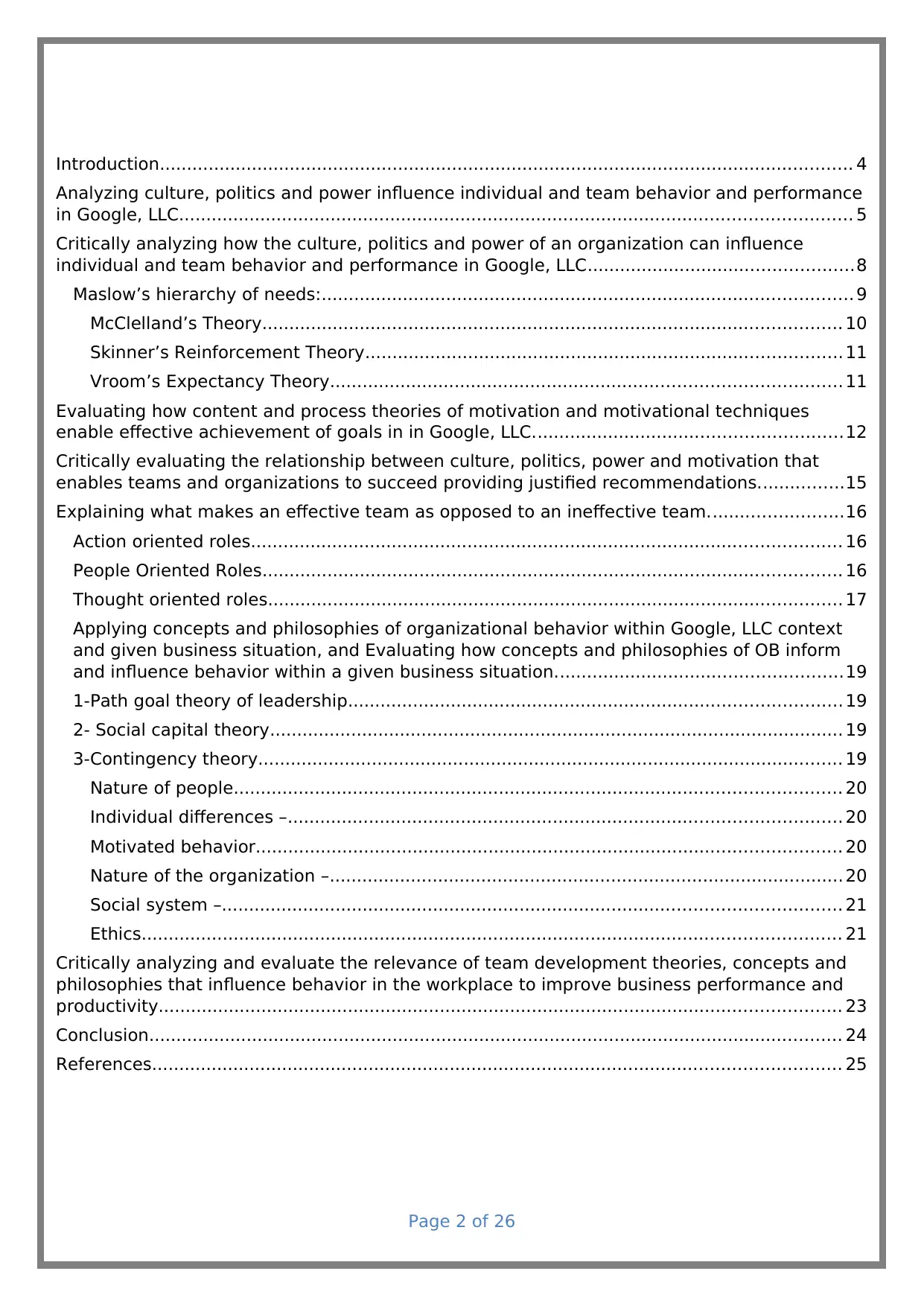
Introduction................................................................................................................................ 4
Analyzing culture, politics and power influence individual and team behavior and performance
in Google, LLC............................................................................................................................ 5
Critically analyzing how the culture, politics and power of an organization can influence
individual and team behavior and performance in Google, LLC.................................................8
Maslow’s hierarchy of needs:.................................................................................................. 9
McClelland’s Theory........................................................................................................... 10
Skinner’s Reinforcement Theory........................................................................................ 11
Vroom’s Expectancy Theory.............................................................................................. 11
Evaluating how content and process theories of motivation and motivational techniques
enable effective achievement of goals in in Google, LLC.........................................................12
Critically evaluating the relationship between culture, politics, power and motivation that
enables teams and organizations to succeed providing justified recommendations................15
Explaining what makes an effective team as opposed to an ineffective team.........................16
Action oriented roles............................................................................................................. 16
People Oriented Roles........................................................................................................... 16
Thought oriented roles.......................................................................................................... 17
Applying concepts and philosophies of organizational behavior within Google, LLC context
and given business situation, and Evaluating how concepts and philosophies of OB inform
and influence behavior within a given business situation.....................................................19
1-Path goal theory of leadership........................................................................................... 19
2- Social capital theory.......................................................................................................... 19
3-Contingency theory............................................................................................................ 19
Nature of people................................................................................................................ 20
Individual differences –...................................................................................................... 20
Motivated behavior............................................................................................................ 20
Nature of the organization –............................................................................................... 20
Social system –.................................................................................................................. 21
Ethics................................................................................................................................. 21
Critically analyzing and evaluate the relevance of team development theories, concepts and
philosophies that influence behavior in the workplace to improve business performance and
productivity.............................................................................................................................. 23
Conclusion................................................................................................................................ 24
References............................................................................................................................... 25
Page 2 of 26
Analyzing culture, politics and power influence individual and team behavior and performance
in Google, LLC............................................................................................................................ 5
Critically analyzing how the culture, politics and power of an organization can influence
individual and team behavior and performance in Google, LLC.................................................8
Maslow’s hierarchy of needs:.................................................................................................. 9
McClelland’s Theory........................................................................................................... 10
Skinner’s Reinforcement Theory........................................................................................ 11
Vroom’s Expectancy Theory.............................................................................................. 11
Evaluating how content and process theories of motivation and motivational techniques
enable effective achievement of goals in in Google, LLC.........................................................12
Critically evaluating the relationship between culture, politics, power and motivation that
enables teams and organizations to succeed providing justified recommendations................15
Explaining what makes an effective team as opposed to an ineffective team.........................16
Action oriented roles............................................................................................................. 16
People Oriented Roles........................................................................................................... 16
Thought oriented roles.......................................................................................................... 17
Applying concepts and philosophies of organizational behavior within Google, LLC context
and given business situation, and Evaluating how concepts and philosophies of OB inform
and influence behavior within a given business situation.....................................................19
1-Path goal theory of leadership........................................................................................... 19
2- Social capital theory.......................................................................................................... 19
3-Contingency theory............................................................................................................ 19
Nature of people................................................................................................................ 20
Individual differences –...................................................................................................... 20
Motivated behavior............................................................................................................ 20
Nature of the organization –............................................................................................... 20
Social system –.................................................................................................................. 21
Ethics................................................................................................................................. 21
Critically analyzing and evaluate the relevance of team development theories, concepts and
philosophies that influence behavior in the workplace to improve business performance and
productivity.............................................................................................................................. 23
Conclusion................................................................................................................................ 24
References............................................................................................................................... 25
Page 2 of 26
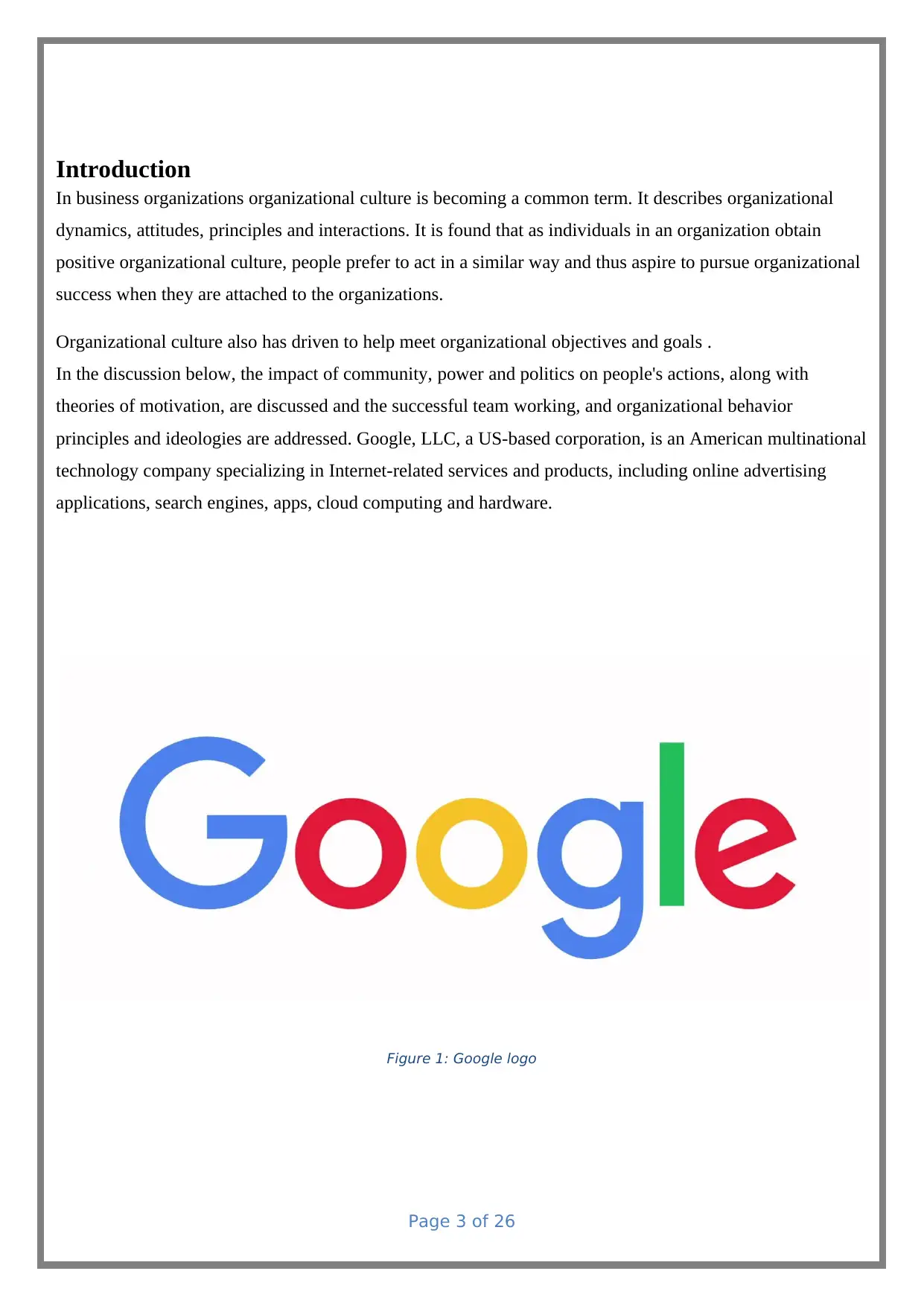
Introduction
In business organizations organizational culture is becoming a common term. It describes organizational
dynamics, attitudes, principles and interactions. It is found that as individuals in an organization obtain
positive organizational culture, people prefer to act in a similar way and thus aspire to pursue organizational
success when they are attached to the organizations.
Organizational culture also has driven to help meet organizational objectives and goals .
In the discussion below, the impact of community, power and politics on people's actions, along with
theories of motivation, are discussed and the successful team working, and organizational behavior
principles and ideologies are addressed. Google, LLC, a US-based corporation, is an American multinational
technology company specializing in Internet-related services and products, including online advertising
applications, search engines, apps, cloud computing and hardware.
Figure 1: Google logo
Page 3 of 26
In business organizations organizational culture is becoming a common term. It describes organizational
dynamics, attitudes, principles and interactions. It is found that as individuals in an organization obtain
positive organizational culture, people prefer to act in a similar way and thus aspire to pursue organizational
success when they are attached to the organizations.
Organizational culture also has driven to help meet organizational objectives and goals .
In the discussion below, the impact of community, power and politics on people's actions, along with
theories of motivation, are discussed and the successful team working, and organizational behavior
principles and ideologies are addressed. Google, LLC, a US-based corporation, is an American multinational
technology company specializing in Internet-related services and products, including online advertising
applications, search engines, apps, cloud computing and hardware.
Figure 1: Google logo
Page 3 of 26
⊘ This is a preview!⊘
Do you want full access?
Subscribe today to unlock all pages.

Trusted by 1+ million students worldwide
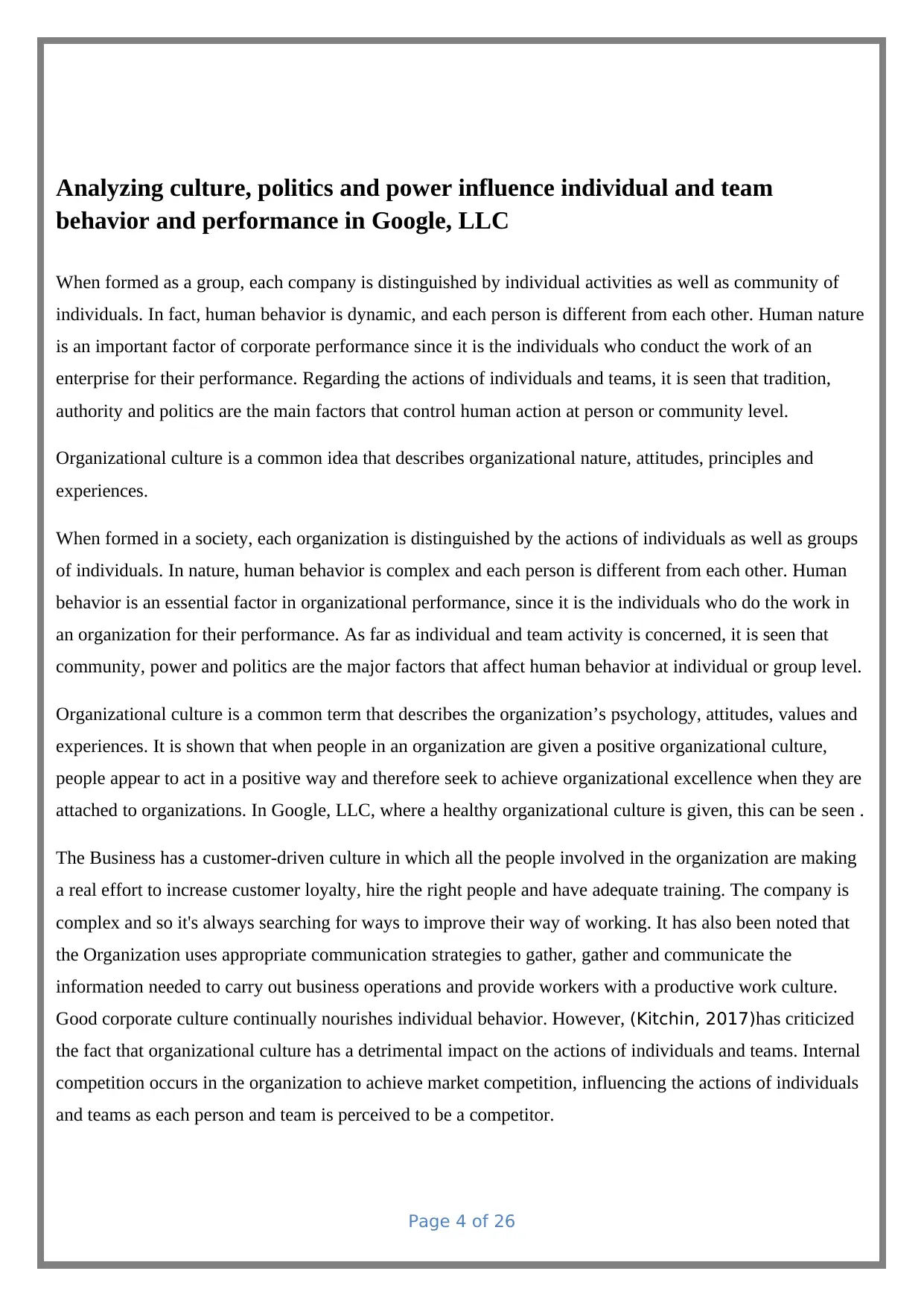
Analyzing culture, politics and power influence individual and team
behavior and performance in Google, LLC
When formed as a group, each company is distinguished by individual activities as well as community of
individuals. In fact, human behavior is dynamic, and each person is different from each other. Human nature
is an important factor of corporate performance since it is the individuals who conduct the work of an
enterprise for their performance. Regarding the actions of individuals and teams, it is seen that tradition,
authority and politics are the main factors that control human action at person or community level.
Organizational culture is a common idea that describes organizational nature, attitudes, principles and
experiences.
When formed in a society, each organization is distinguished by the actions of individuals as well as groups
of individuals. In nature, human behavior is complex and each person is different from each other. Human
behavior is an essential factor in organizational performance, since it is the individuals who do the work in
an organization for their performance. As far as individual and team activity is concerned, it is seen that
community, power and politics are the major factors that affect human behavior at individual or group level.
Organizational culture is a common term that describes the organization’s psychology, attitudes, values and
experiences. It is shown that when people in an organization are given a positive organizational culture,
people appear to act in a positive way and therefore seek to achieve organizational excellence when they are
attached to organizations. In Google, LLC, where a healthy organizational culture is given, this can be seen .
The Business has a customer-driven culture in which all the people involved in the organization are making
a real effort to increase customer loyalty, hire the right people and have adequate training. The company is
complex and so it's always searching for ways to improve their way of working. It has also been noted that
the Organization uses appropriate communication strategies to gather, gather and communicate the
information needed to carry out business operations and provide workers with a productive work culture.
Good corporate culture continually nourishes individual behavior. However, (Kitchin, 2017)has criticized
the fact that organizational culture has a detrimental impact on the actions of individuals and teams. Internal
competition occurs in the organization to achieve market competition, influencing the actions of individuals
and teams as each person and team is perceived to be a competitor.
Page 4 of 26
behavior and performance in Google, LLC
When formed as a group, each company is distinguished by individual activities as well as community of
individuals. In fact, human behavior is dynamic, and each person is different from each other. Human nature
is an important factor of corporate performance since it is the individuals who conduct the work of an
enterprise for their performance. Regarding the actions of individuals and teams, it is seen that tradition,
authority and politics are the main factors that control human action at person or community level.
Organizational culture is a common idea that describes organizational nature, attitudes, principles and
experiences.
When formed in a society, each organization is distinguished by the actions of individuals as well as groups
of individuals. In nature, human behavior is complex and each person is different from each other. Human
behavior is an essential factor in organizational performance, since it is the individuals who do the work in
an organization for their performance. As far as individual and team activity is concerned, it is seen that
community, power and politics are the major factors that affect human behavior at individual or group level.
Organizational culture is a common term that describes the organization’s psychology, attitudes, values and
experiences. It is shown that when people in an organization are given a positive organizational culture,
people appear to act in a positive way and therefore seek to achieve organizational excellence when they are
attached to organizations. In Google, LLC, where a healthy organizational culture is given, this can be seen .
The Business has a customer-driven culture in which all the people involved in the organization are making
a real effort to increase customer loyalty, hire the right people and have adequate training. The company is
complex and so it's always searching for ways to improve their way of working. It has also been noted that
the Organization uses appropriate communication strategies to gather, gather and communicate the
information needed to carry out business operations and provide workers with a productive work culture.
Good corporate culture continually nourishes individual behavior. However, (Kitchin, 2017)has criticized
the fact that organizational culture has a detrimental impact on the actions of individuals and teams. Internal
competition occurs in the organization to achieve market competition, influencing the actions of individuals
and teams as each person and team is perceived to be a competitor.
Page 4 of 26
Paraphrase This Document
Need a fresh take? Get an instant paraphrase of this document with our AI Paraphraser
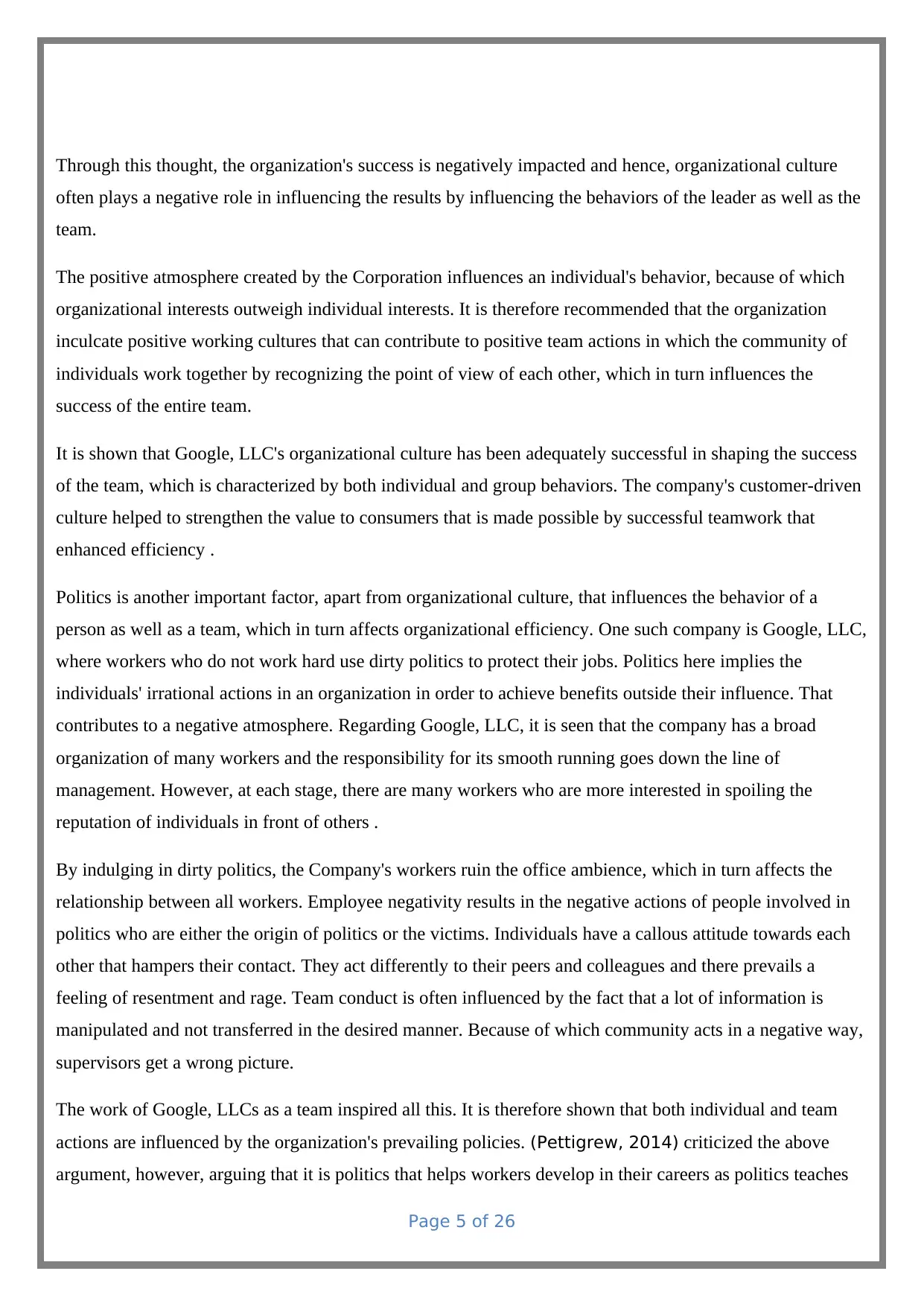
Through this thought, the organization's success is negatively impacted and hence, organizational culture
often plays a negative role in influencing the results by influencing the behaviors of the leader as well as the
team.
The positive atmosphere created by the Corporation influences an individual's behavior, because of which
organizational interests outweigh individual interests. It is therefore recommended that the organization
inculcate positive working cultures that can contribute to positive team actions in which the community of
individuals work together by recognizing the point of view of each other, which in turn influences the
success of the entire team.
It is shown that Google, LLC's organizational culture has been adequately successful in shaping the success
of the team, which is characterized by both individual and group behaviors. The company's customer-driven
culture helped to strengthen the value to consumers that is made possible by successful teamwork that
enhanced efficiency .
Politics is another important factor, apart from organizational culture, that influences the behavior of a
person as well as a team, which in turn affects organizational efficiency. One such company is Google, LLC,
where workers who do not work hard use dirty politics to protect their jobs. Politics here implies the
individuals' irrational actions in an organization in order to achieve benefits outside their influence. That
contributes to a negative atmosphere. Regarding Google, LLC, it is seen that the company has a broad
organization of many workers and the responsibility for its smooth running goes down the line of
management. However, at each stage, there are many workers who are more interested in spoiling the
reputation of individuals in front of others .
By indulging in dirty politics, the Company's workers ruin the office ambience, which in turn affects the
relationship between all workers. Employee negativity results in the negative actions of people involved in
politics who are either the origin of politics or the victims. Individuals have a callous attitude towards each
other that hampers their contact. They act differently to their peers and colleagues and there prevails a
feeling of resentment and rage. Team conduct is often influenced by the fact that a lot of information is
manipulated and not transferred in the desired manner. Because of which community acts in a negative way,
supervisors get a wrong picture.
The work of Google, LLCs as a team inspired all this. It is therefore shown that both individual and team
actions are influenced by the organization's prevailing policies. (Pettigrew, 2014) criticized the above
argument, however, arguing that it is politics that helps workers develop in their careers as politics teaches
Page 5 of 26
often plays a negative role in influencing the results by influencing the behaviors of the leader as well as the
team.
The positive atmosphere created by the Corporation influences an individual's behavior, because of which
organizational interests outweigh individual interests. It is therefore recommended that the organization
inculcate positive working cultures that can contribute to positive team actions in which the community of
individuals work together by recognizing the point of view of each other, which in turn influences the
success of the entire team.
It is shown that Google, LLC's organizational culture has been adequately successful in shaping the success
of the team, which is characterized by both individual and group behaviors. The company's customer-driven
culture helped to strengthen the value to consumers that is made possible by successful teamwork that
enhanced efficiency .
Politics is another important factor, apart from organizational culture, that influences the behavior of a
person as well as a team, which in turn affects organizational efficiency. One such company is Google, LLC,
where workers who do not work hard use dirty politics to protect their jobs. Politics here implies the
individuals' irrational actions in an organization in order to achieve benefits outside their influence. That
contributes to a negative atmosphere. Regarding Google, LLC, it is seen that the company has a broad
organization of many workers and the responsibility for its smooth running goes down the line of
management. However, at each stage, there are many workers who are more interested in spoiling the
reputation of individuals in front of others .
By indulging in dirty politics, the Company's workers ruin the office ambience, which in turn affects the
relationship between all workers. Employee negativity results in the negative actions of people involved in
politics who are either the origin of politics or the victims. Individuals have a callous attitude towards each
other that hampers their contact. They act differently to their peers and colleagues and there prevails a
feeling of resentment and rage. Team conduct is often influenced by the fact that a lot of information is
manipulated and not transferred in the desired manner. Because of which community acts in a negative way,
supervisors get a wrong picture.
The work of Google, LLCs as a team inspired all this. It is therefore shown that both individual and team
actions are influenced by the organization's prevailing policies. (Pettigrew, 2014) criticized the above
argument, however, arguing that it is politics that helps workers develop in their careers as politics teaches
Page 5 of 26
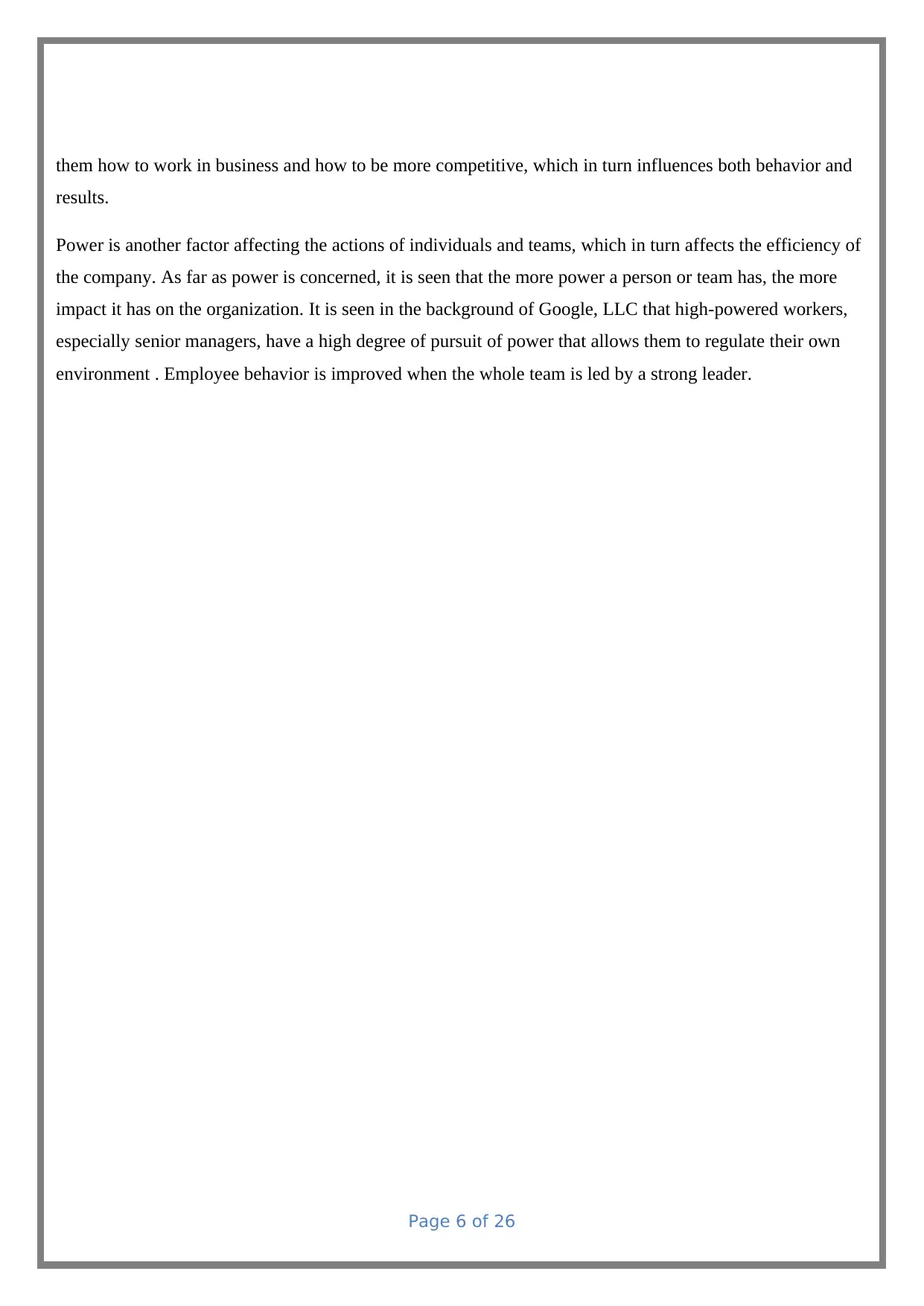
them how to work in business and how to be more competitive, which in turn influences both behavior and
results.
Power is another factor affecting the actions of individuals and teams, which in turn affects the efficiency of
the company. As far as power is concerned, it is seen that the more power a person or team has, the more
impact it has on the organization. It is seen in the background of Google, LLC that high-powered workers,
especially senior managers, have a high degree of pursuit of power that allows them to regulate their own
environment . Employee behavior is improved when the whole team is led by a strong leader.
Page 6 of 26
results.
Power is another factor affecting the actions of individuals and teams, which in turn affects the efficiency of
the company. As far as power is concerned, it is seen that the more power a person or team has, the more
impact it has on the organization. It is seen in the background of Google, LLC that high-powered workers,
especially senior managers, have a high degree of pursuit of power that allows them to regulate their own
environment . Employee behavior is improved when the whole team is led by a strong leader.
Page 6 of 26
⊘ This is a preview!⊘
Do you want full access?
Subscribe today to unlock all pages.

Trusted by 1+ million students worldwide
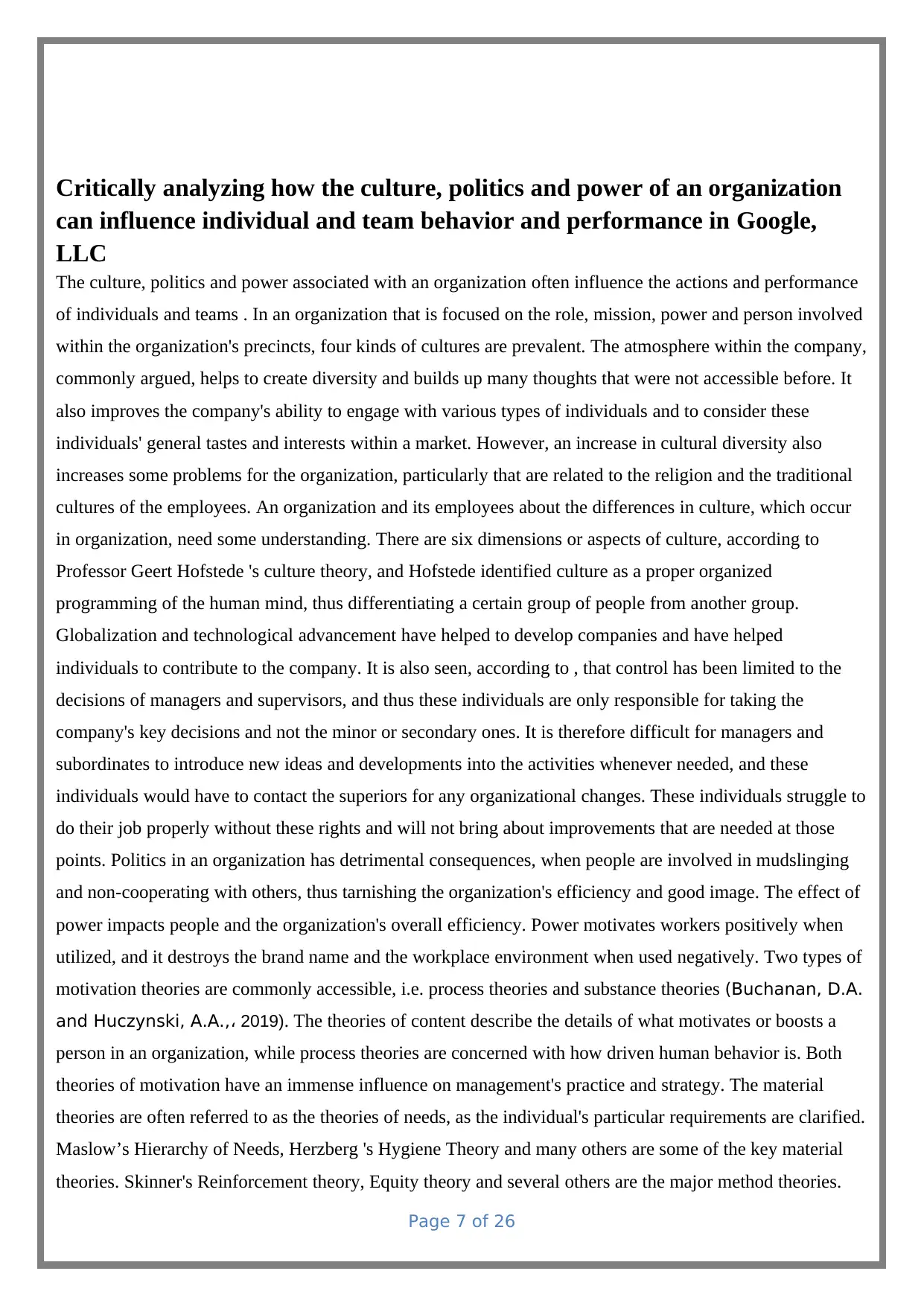
Critically analyzing how the culture, politics and power of an organization
can influence individual and team behavior and performance in Google,
LLC
The culture, politics and power associated with an organization often influence the actions and performance
of individuals and teams . In an organization that is focused on the role, mission, power and person involved
within the organization's precincts, four kinds of cultures are prevalent. The atmosphere within the company,
commonly argued, helps to create diversity and builds up many thoughts that were not accessible before. It
also improves the company's ability to engage with various types of individuals and to consider these
individuals' general tastes and interests within a market. However, an increase in cultural diversity also
increases some problems for the organization, particularly that are related to the religion and the traditional
cultures of the employees. An organization and its employees about the differences in culture, which occur
in organization, need some understanding. There are six dimensions or aspects of culture, according to
Professor Geert Hofstede 's culture theory, and Hofstede identified culture as a proper organized
programming of the human mind, thus differentiating a certain group of people from another group.
Globalization and technological advancement have helped to develop companies and have helped
individuals to contribute to the company. It is also seen, according to , that control has been limited to the
decisions of managers and supervisors, and thus these individuals are only responsible for taking the
company's key decisions and not the minor or secondary ones. It is therefore difficult for managers and
subordinates to introduce new ideas and developments into the activities whenever needed, and these
individuals would have to contact the superiors for any organizational changes. These individuals struggle to
do their job properly without these rights and will not bring about improvements that are needed at those
points. Politics in an organization has detrimental consequences, when people are involved in mudslinging
and non-cooperating with others, thus tarnishing the organization's efficiency and good image. The effect of
power impacts people and the organization's overall efficiency. Power motivates workers positively when
utilized, and it destroys the brand name and the workplace environment when used negatively. Two types of
motivation theories are commonly accessible, i.e. process theories and substance theories (Buchanan, D.A.
and Huczynski, A.A., 2019)، . The theories of content describe the details of what motivates or boosts a
person in an organization, while process theories are concerned with how driven human behavior is. Both
theories of motivation have an immense influence on management's practice and strategy. The material
theories are often referred to as the theories of needs, as the individual's particular requirements are clarified.
Maslow’s Hierarchy of Needs, Herzberg 's Hygiene Theory and many others are some of the key material
theories. Skinner's Reinforcement theory, Equity theory and several others are the major method theories.
Page 7 of 26
can influence individual and team behavior and performance in Google,
LLC
The culture, politics and power associated with an organization often influence the actions and performance
of individuals and teams . In an organization that is focused on the role, mission, power and person involved
within the organization's precincts, four kinds of cultures are prevalent. The atmosphere within the company,
commonly argued, helps to create diversity and builds up many thoughts that were not accessible before. It
also improves the company's ability to engage with various types of individuals and to consider these
individuals' general tastes and interests within a market. However, an increase in cultural diversity also
increases some problems for the organization, particularly that are related to the religion and the traditional
cultures of the employees. An organization and its employees about the differences in culture, which occur
in organization, need some understanding. There are six dimensions or aspects of culture, according to
Professor Geert Hofstede 's culture theory, and Hofstede identified culture as a proper organized
programming of the human mind, thus differentiating a certain group of people from another group.
Globalization and technological advancement have helped to develop companies and have helped
individuals to contribute to the company. It is also seen, according to , that control has been limited to the
decisions of managers and supervisors, and thus these individuals are only responsible for taking the
company's key decisions and not the minor or secondary ones. It is therefore difficult for managers and
subordinates to introduce new ideas and developments into the activities whenever needed, and these
individuals would have to contact the superiors for any organizational changes. These individuals struggle to
do their job properly without these rights and will not bring about improvements that are needed at those
points. Politics in an organization has detrimental consequences, when people are involved in mudslinging
and non-cooperating with others, thus tarnishing the organization's efficiency and good image. The effect of
power impacts people and the organization's overall efficiency. Power motivates workers positively when
utilized, and it destroys the brand name and the workplace environment when used negatively. Two types of
motivation theories are commonly accessible, i.e. process theories and substance theories (Buchanan, D.A.
and Huczynski, A.A., 2019)، . The theories of content describe the details of what motivates or boosts a
person in an organization, while process theories are concerned with how driven human behavior is. Both
theories of motivation have an immense influence on management's practice and strategy. The material
theories are often referred to as the theories of needs, as the individual's particular requirements are clarified.
Maslow’s Hierarchy of Needs, Herzberg 's Hygiene Theory and many others are some of the key material
theories. Skinner's Reinforcement theory, Equity theory and several others are the major method theories.
Page 7 of 26
Paraphrase This Document
Need a fresh take? Get an instant paraphrase of this document with our AI Paraphraser
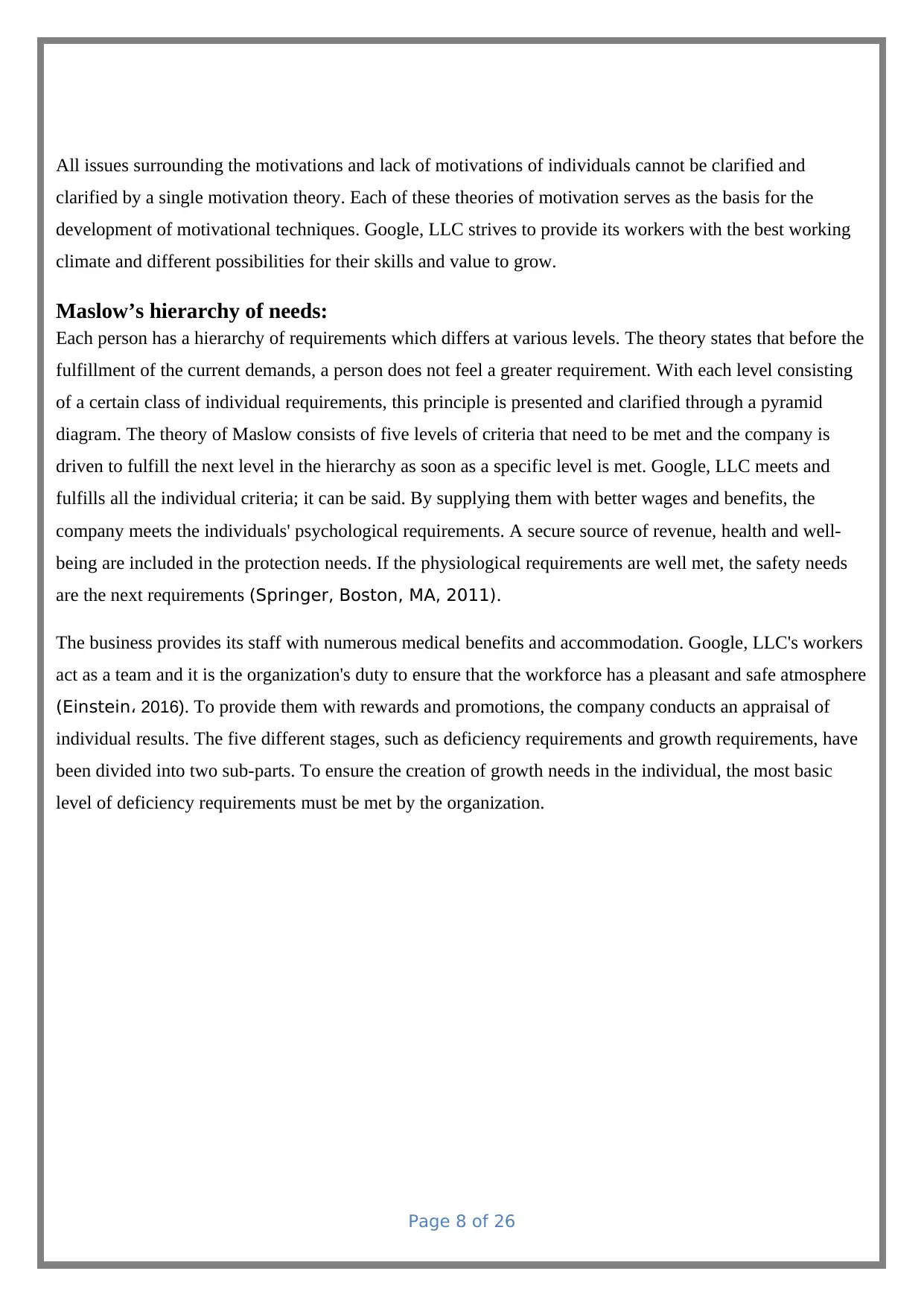
All issues surrounding the motivations and lack of motivations of individuals cannot be clarified and
clarified by a single motivation theory. Each of these theories of motivation serves as the basis for the
development of motivational techniques. Google, LLC strives to provide its workers with the best working
climate and different possibilities for their skills and value to grow.
Maslow’s hierarchy of needs:
Each person has a hierarchy of requirements which differs at various levels. The theory states that before the
fulfillment of the current demands, a person does not feel a greater requirement. With each level consisting
of a certain class of individual requirements, this principle is presented and clarified through a pyramid
diagram. The theory of Maslow consists of five levels of criteria that need to be met and the company is
driven to fulfill the next level in the hierarchy as soon as a specific level is met. Google, LLC meets and
fulfills all the individual criteria; it can be said. By supplying them with better wages and benefits, the
company meets the individuals' psychological requirements. A secure source of revenue, health and well-
being are included in the protection needs. If the physiological requirements are well met, the safety needs
are the next requirements (Springer, Boston, MA, 2011).
The business provides its staff with numerous medical benefits and accommodation. Google, LLC's workers
act as a team and it is the organization's duty to ensure that the workforce has a pleasant and safe atmosphere
(Einstein 2016)، . To provide them with rewards and promotions, the company conducts an appraisal of
individual results. The five different stages, such as deficiency requirements and growth requirements, have
been divided into two sub-parts. To ensure the creation of growth needs in the individual, the most basic
level of deficiency requirements must be met by the organization.
Page 8 of 26
clarified by a single motivation theory. Each of these theories of motivation serves as the basis for the
development of motivational techniques. Google, LLC strives to provide its workers with the best working
climate and different possibilities for their skills and value to grow.
Maslow’s hierarchy of needs:
Each person has a hierarchy of requirements which differs at various levels. The theory states that before the
fulfillment of the current demands, a person does not feel a greater requirement. With each level consisting
of a certain class of individual requirements, this principle is presented and clarified through a pyramid
diagram. The theory of Maslow consists of five levels of criteria that need to be met and the company is
driven to fulfill the next level in the hierarchy as soon as a specific level is met. Google, LLC meets and
fulfills all the individual criteria; it can be said. By supplying them with better wages and benefits, the
company meets the individuals' psychological requirements. A secure source of revenue, health and well-
being are included in the protection needs. If the physiological requirements are well met, the safety needs
are the next requirements (Springer, Boston, MA, 2011).
The business provides its staff with numerous medical benefits and accommodation. Google, LLC's workers
act as a team and it is the organization's duty to ensure that the workforce has a pleasant and safe atmosphere
(Einstein 2016)، . To provide them with rewards and promotions, the company conducts an appraisal of
individual results. The five different stages, such as deficiency requirements and growth requirements, have
been divided into two sub-parts. To ensure the creation of growth needs in the individual, the most basic
level of deficiency requirements must be met by the organization.
Page 8 of 26
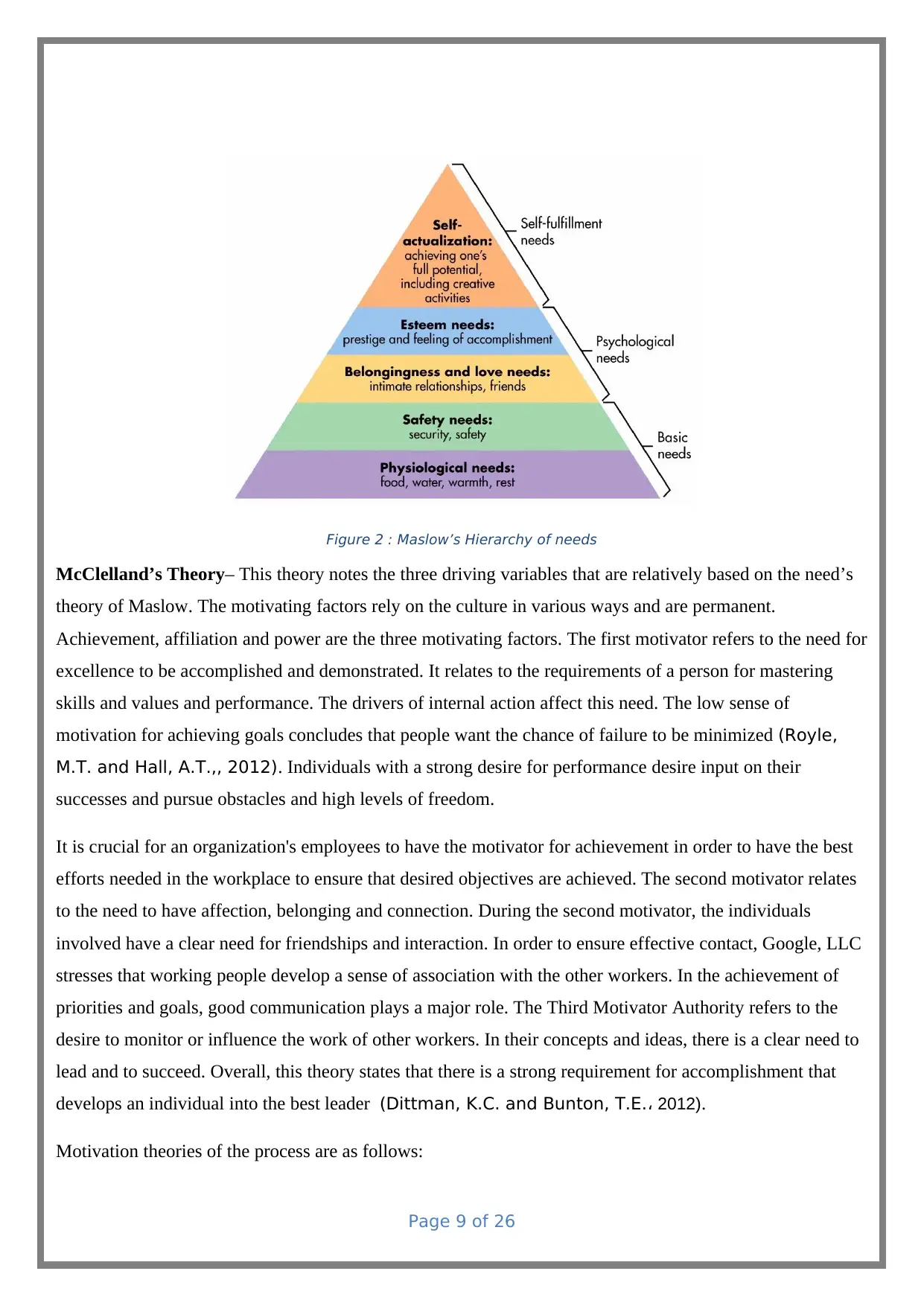
Figure 2 : Maslow’s Hierarchy of needs
McClelland’s Theory– This theory notes the three driving variables that are relatively based on the need’s
theory of Maslow. The motivating factors rely on the culture in various ways and are permanent.
Achievement, affiliation and power are the three motivating factors. The first motivator refers to the need for
excellence to be accomplished and demonstrated. It relates to the requirements of a person for mastering
skills and values and performance. The drivers of internal action affect this need. The low sense of
motivation for achieving goals concludes that people want the chance of failure to be minimized (Royle,
M.T. and Hall, A.T.,, 2012). Individuals with a strong desire for performance desire input on their
successes and pursue obstacles and high levels of freedom.
It is crucial for an organization's employees to have the motivator for achievement in order to have the best
efforts needed in the workplace to ensure that desired objectives are achieved. The second motivator relates
to the need to have affection, belonging and connection. During the second motivator, the individuals
involved have a clear need for friendships and interaction. In order to ensure effective contact, Google, LLC
stresses that working people develop a sense of association with the other workers. In the achievement of
priorities and goals, good communication plays a major role. The Third Motivator Authority refers to the
desire to monitor or influence the work of other workers. In their concepts and ideas, there is a clear need to
lead and to succeed. Overall, this theory states that there is a strong requirement for accomplishment that
develops an individual into the best leader (Dittman, K.C. and Bunton, T.E. 2012)، .
Motivation theories of the process are as follows:
Page 9 of 26
McClelland’s Theory– This theory notes the three driving variables that are relatively based on the need’s
theory of Maslow. The motivating factors rely on the culture in various ways and are permanent.
Achievement, affiliation and power are the three motivating factors. The first motivator refers to the need for
excellence to be accomplished and demonstrated. It relates to the requirements of a person for mastering
skills and values and performance. The drivers of internal action affect this need. The low sense of
motivation for achieving goals concludes that people want the chance of failure to be minimized (Royle,
M.T. and Hall, A.T.,, 2012). Individuals with a strong desire for performance desire input on their
successes and pursue obstacles and high levels of freedom.
It is crucial for an organization's employees to have the motivator for achievement in order to have the best
efforts needed in the workplace to ensure that desired objectives are achieved. The second motivator relates
to the need to have affection, belonging and connection. During the second motivator, the individuals
involved have a clear need for friendships and interaction. In order to ensure effective contact, Google, LLC
stresses that working people develop a sense of association with the other workers. In the achievement of
priorities and goals, good communication plays a major role. The Third Motivator Authority refers to the
desire to monitor or influence the work of other workers. In their concepts and ideas, there is a clear need to
lead and to succeed. Overall, this theory states that there is a strong requirement for accomplishment that
develops an individual into the best leader (Dittman, K.C. and Bunton, T.E. 2012)، .
Motivation theories of the process are as follows:
Page 9 of 26
⊘ This is a preview!⊘
Do you want full access?
Subscribe today to unlock all pages.

Trusted by 1+ million students worldwide
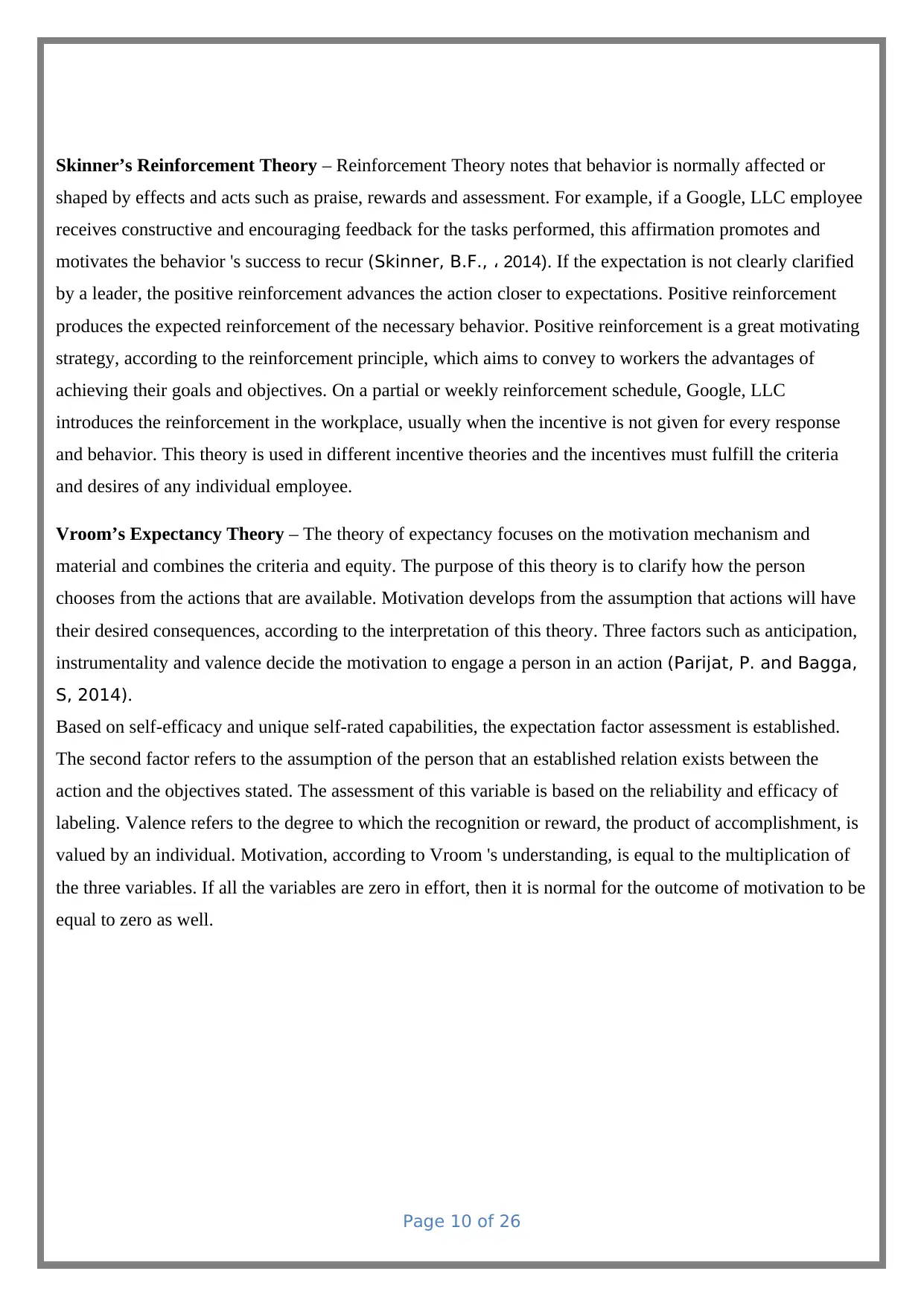
Skinner’s Reinforcement Theory – Reinforcement Theory notes that behavior is normally affected or
shaped by effects and acts such as praise, rewards and assessment. For example, if a Google, LLC employee
receives constructive and encouraging feedback for the tasks performed, this affirmation promotes and
motivates the behavior 's success to recur (Skinner, B.F., 2014)، . If the expectation is not clearly clarified
by a leader, the positive reinforcement advances the action closer to expectations. Positive reinforcement
produces the expected reinforcement of the necessary behavior. Positive reinforcement is a great motivating
strategy, according to the reinforcement principle, which aims to convey to workers the advantages of
achieving their goals and objectives. On a partial or weekly reinforcement schedule, Google, LLC
introduces the reinforcement in the workplace, usually when the incentive is not given for every response
and behavior. This theory is used in different incentive theories and the incentives must fulfill the criteria
and desires of any individual employee.
Vroom’s Expectancy Theory – The theory of expectancy focuses on the motivation mechanism and
material and combines the criteria and equity. The purpose of this theory is to clarify how the person
chooses from the actions that are available. Motivation develops from the assumption that actions will have
their desired consequences, according to the interpretation of this theory. Three factors such as anticipation,
instrumentality and valence decide the motivation to engage a person in an action (Parijat, P. and Bagga,
S, 2014).
Based on self-efficacy and unique self-rated capabilities, the expectation factor assessment is established.
The second factor refers to the assumption of the person that an established relation exists between the
action and the objectives stated. The assessment of this variable is based on the reliability and efficacy of
labeling. Valence refers to the degree to which the recognition or reward, the product of accomplishment, is
valued by an individual. Motivation, according to Vroom 's understanding, is equal to the multiplication of
the three variables. If all the variables are zero in effort, then it is normal for the outcome of motivation to be
equal to zero as well.
Page 10 of 26
shaped by effects and acts such as praise, rewards and assessment. For example, if a Google, LLC employee
receives constructive and encouraging feedback for the tasks performed, this affirmation promotes and
motivates the behavior 's success to recur (Skinner, B.F., 2014)، . If the expectation is not clearly clarified
by a leader, the positive reinforcement advances the action closer to expectations. Positive reinforcement
produces the expected reinforcement of the necessary behavior. Positive reinforcement is a great motivating
strategy, according to the reinforcement principle, which aims to convey to workers the advantages of
achieving their goals and objectives. On a partial or weekly reinforcement schedule, Google, LLC
introduces the reinforcement in the workplace, usually when the incentive is not given for every response
and behavior. This theory is used in different incentive theories and the incentives must fulfill the criteria
and desires of any individual employee.
Vroom’s Expectancy Theory – The theory of expectancy focuses on the motivation mechanism and
material and combines the criteria and equity. The purpose of this theory is to clarify how the person
chooses from the actions that are available. Motivation develops from the assumption that actions will have
their desired consequences, according to the interpretation of this theory. Three factors such as anticipation,
instrumentality and valence decide the motivation to engage a person in an action (Parijat, P. and Bagga,
S, 2014).
Based on self-efficacy and unique self-rated capabilities, the expectation factor assessment is established.
The second factor refers to the assumption of the person that an established relation exists between the
action and the objectives stated. The assessment of this variable is based on the reliability and efficacy of
labeling. Valence refers to the degree to which the recognition or reward, the product of accomplishment, is
valued by an individual. Motivation, according to Vroom 's understanding, is equal to the multiplication of
the three variables. If all the variables are zero in effort, then it is normal for the outcome of motivation to be
equal to zero as well.
Page 10 of 26
Paraphrase This Document
Need a fresh take? Get an instant paraphrase of this document with our AI Paraphraser
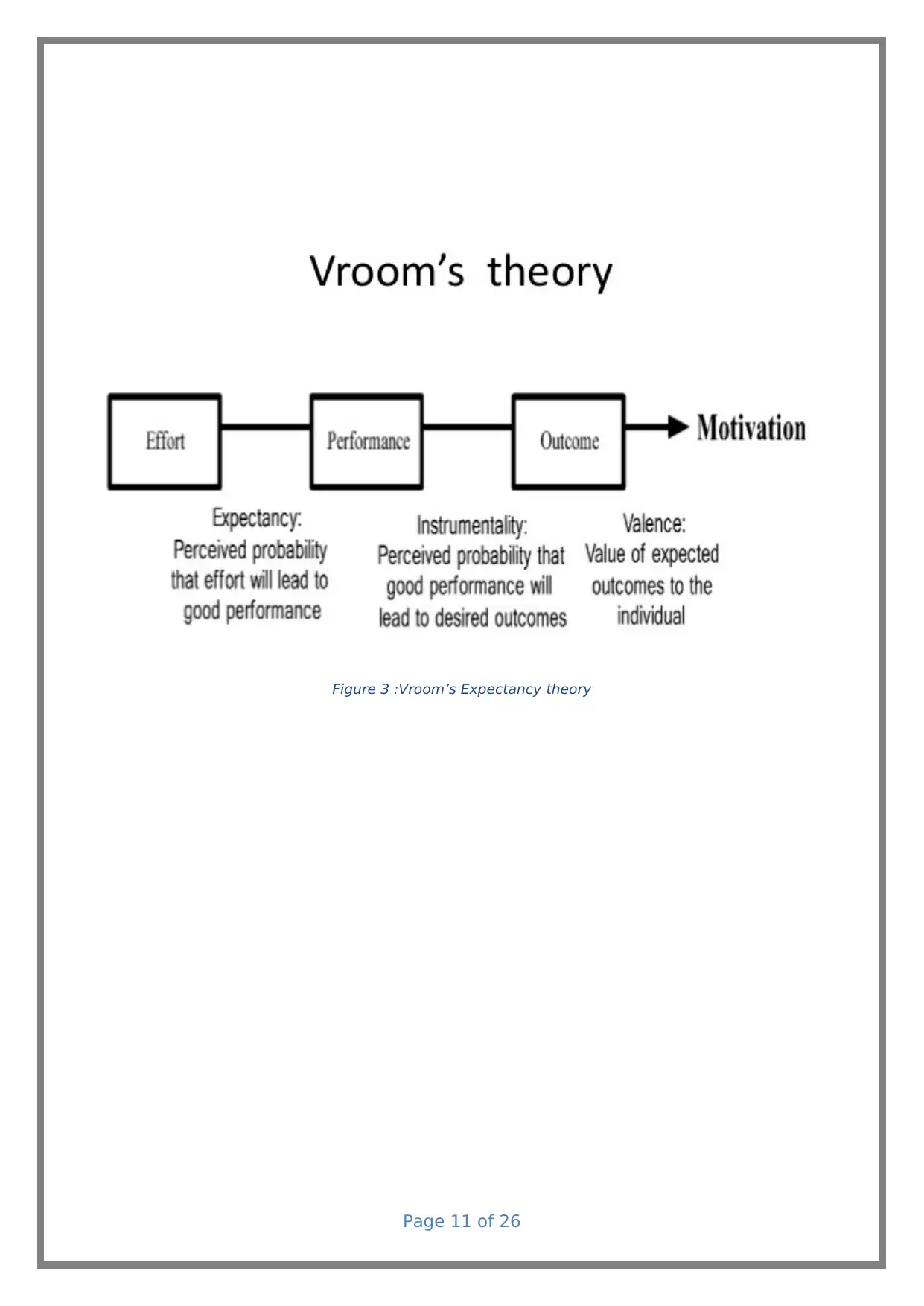
Figure 3 :Vroom’s Expectancy theory
Page 11 of 26
Page 11 of 26
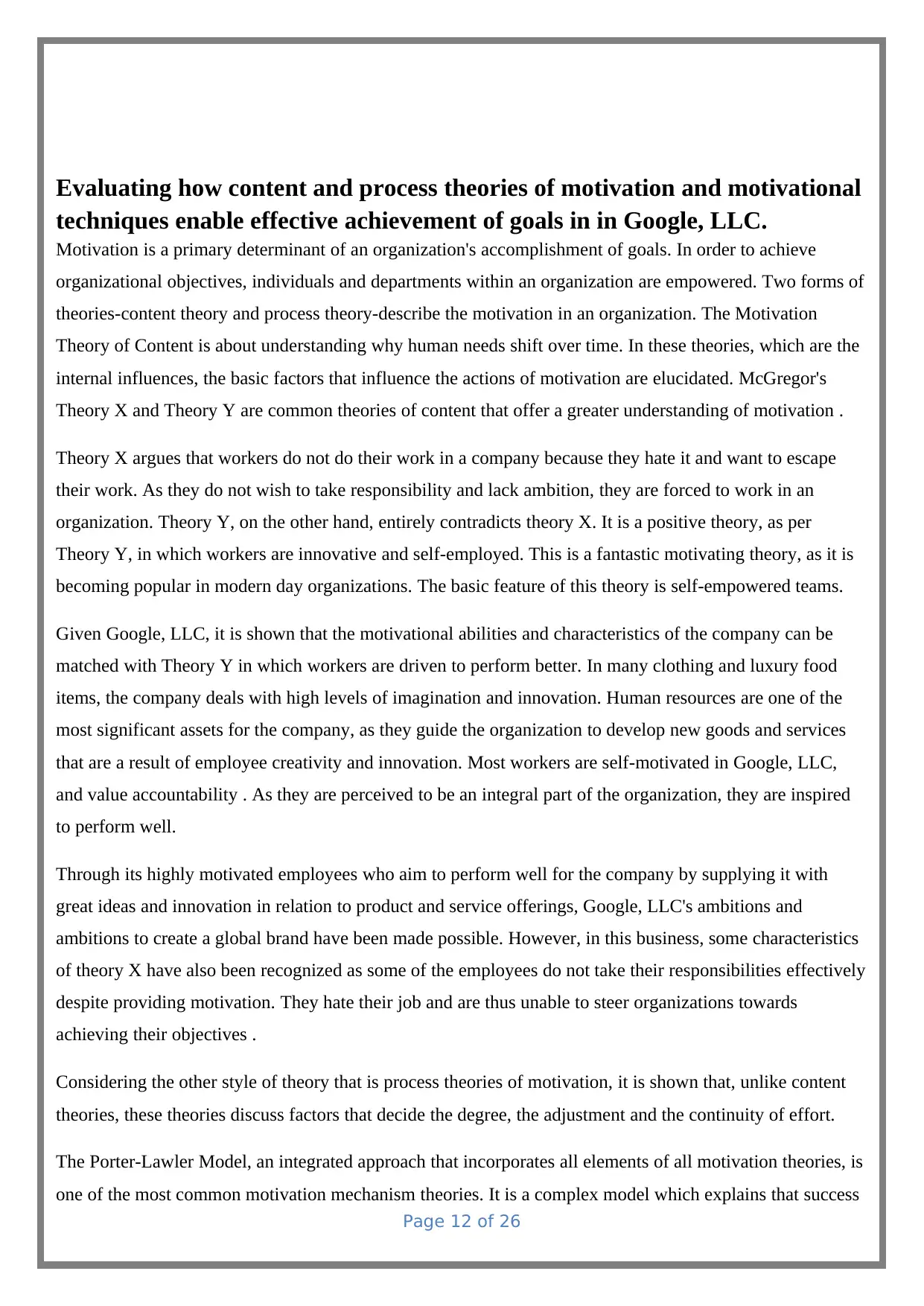
Evaluating how content and process theories of motivation and motivational
techniques enable effective achievement of goals in in Google, LLC.
Motivation is a primary determinant of an organization's accomplishment of goals. In order to achieve
organizational objectives, individuals and departments within an organization are empowered. Two forms of
theories-content theory and process theory-describe the motivation in an organization. The Motivation
Theory of Content is about understanding why human needs shift over time. In these theories, which are the
internal influences, the basic factors that influence the actions of motivation are elucidated. McGregor's
Theory X and Theory Y are common theories of content that offer a greater understanding of motivation .
Theory X argues that workers do not do their work in a company because they hate it and want to escape
their work. As they do not wish to take responsibility and lack ambition, they are forced to work in an
organization. Theory Y, on the other hand, entirely contradicts theory X. It is a positive theory, as per
Theory Y, in which workers are innovative and self-employed. This is a fantastic motivating theory, as it is
becoming popular in modern day organizations. The basic feature of this theory is self-empowered teams.
Given Google, LLC, it is shown that the motivational abilities and characteristics of the company can be
matched with Theory Y in which workers are driven to perform better. In many clothing and luxury food
items, the company deals with high levels of imagination and innovation. Human resources are one of the
most significant assets for the company, as they guide the organization to develop new goods and services
that are a result of employee creativity and innovation. Most workers are self-motivated in Google, LLC,
and value accountability . As they are perceived to be an integral part of the organization, they are inspired
to perform well.
Through its highly motivated employees who aim to perform well for the company by supplying it with
great ideas and innovation in relation to product and service offerings, Google, LLC's ambitions and
ambitions to create a global brand have been made possible. However, in this business, some characteristics
of theory X have also been recognized as some of the employees do not take their responsibilities effectively
despite providing motivation. They hate their job and are thus unable to steer organizations towards
achieving their objectives .
Considering the other style of theory that is process theories of motivation, it is shown that, unlike content
theories, these theories discuss factors that decide the degree, the adjustment and the continuity of effort.
The Porter-Lawler Model, an integrated approach that incorporates all elements of all motivation theories, is
one of the most common motivation mechanism theories. It is a complex model which explains that success
Page 12 of 26
techniques enable effective achievement of goals in in Google, LLC.
Motivation is a primary determinant of an organization's accomplishment of goals. In order to achieve
organizational objectives, individuals and departments within an organization are empowered. Two forms of
theories-content theory and process theory-describe the motivation in an organization. The Motivation
Theory of Content is about understanding why human needs shift over time. In these theories, which are the
internal influences, the basic factors that influence the actions of motivation are elucidated. McGregor's
Theory X and Theory Y are common theories of content that offer a greater understanding of motivation .
Theory X argues that workers do not do their work in a company because they hate it and want to escape
their work. As they do not wish to take responsibility and lack ambition, they are forced to work in an
organization. Theory Y, on the other hand, entirely contradicts theory X. It is a positive theory, as per
Theory Y, in which workers are innovative and self-employed. This is a fantastic motivating theory, as it is
becoming popular in modern day organizations. The basic feature of this theory is self-empowered teams.
Given Google, LLC, it is shown that the motivational abilities and characteristics of the company can be
matched with Theory Y in which workers are driven to perform better. In many clothing and luxury food
items, the company deals with high levels of imagination and innovation. Human resources are one of the
most significant assets for the company, as they guide the organization to develop new goods and services
that are a result of employee creativity and innovation. Most workers are self-motivated in Google, LLC,
and value accountability . As they are perceived to be an integral part of the organization, they are inspired
to perform well.
Through its highly motivated employees who aim to perform well for the company by supplying it with
great ideas and innovation in relation to product and service offerings, Google, LLC's ambitions and
ambitions to create a global brand have been made possible. However, in this business, some characteristics
of theory X have also been recognized as some of the employees do not take their responsibilities effectively
despite providing motivation. They hate their job and are thus unable to steer organizations towards
achieving their objectives .
Considering the other style of theory that is process theories of motivation, it is shown that, unlike content
theories, these theories discuss factors that decide the degree, the adjustment and the continuity of effort.
The Porter-Lawler Model, an integrated approach that incorporates all elements of all motivation theories, is
one of the most common motivation mechanism theories. It is a complex model which explains that success
Page 12 of 26
⊘ This is a preview!⊘
Do you want full access?
Subscribe today to unlock all pages.

Trusted by 1+ million students worldwide
1 out of 26
Related Documents
Your All-in-One AI-Powered Toolkit for Academic Success.
+13062052269
info@desklib.com
Available 24*7 on WhatsApp / Email
![[object Object]](/_next/static/media/star-bottom.7253800d.svg)
Unlock your academic potential
Copyright © 2020–2025 A2Z Services. All Rights Reserved. Developed and managed by ZUCOL.




